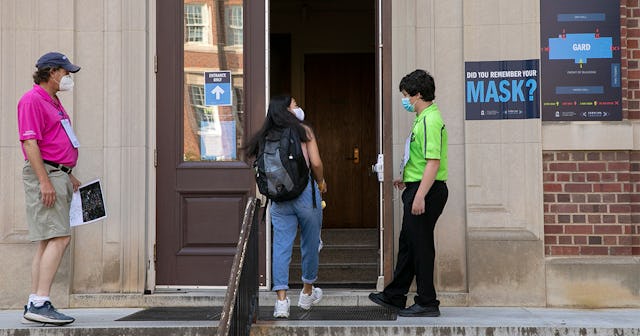UNC Chapel Hill Reports Fourth COVID Cluster In 3 Days

The decision was made to open campus and classrooms for students beginning Aug. 10
The University of North Carolina at Chapel Hill opened its classrooms and had students back on campus for the fall semester on August 10. Shortly afterwards, the school announced clusters of coronavirus cases popping up, and on Sunday it identified yet another cluster, the fourth reported in three days.
This latest cluster (defined as five or more cases in a residential hall or dwelling) has been located at Hinton James Residence Hall, the university said in an alert. “The individuals in this cluster have been identified and are isolating and receiving medical monitoring. We have also notified the Orange County Health Department and are working with them to identify additional potential exposures,” it said.
According to the university’s website, this Hall is typically a freshman dorm which can house approximately 900 students. As of Friday, a total of 149 students and 40 employees have tested positive for the coronavirus at UNC-Chapel Hill since February. Ten students and one staff member tested positive in just one week ending August 9.
On Aug. 14, the university announced two separate sets of clusters: one at a residence hall and one at a privately managed apartment complex that houses students. A third cluster was identified at an off-campus fraternity house the following day.
UNC-Chapel Hill began the year with 5,800 students in dorms, which accounted for more than half of the available beds, The Washington Post reported. Classes include face-to-face, remote only, and a hybrid approach but with clusters continuing to be located, it’s anyone’s guess how long in-person classes will go on.
The back-to-school plan included guidelines for face masks, social distancing, and capping on-campus gatherings to 25 people both indoors and outdoors.
Kevin M. Guskiewicz, the university chancellor, defended the fall opening, saying it was developed with guidance from experts in infectious disease and epidemiology. As the father of a Chapel Hill student, he said he “would never ask the parent of another student to do something I wouldn’t do as a parent for my child.
At the end of the day, I realized I’ve got to make a call based on the information I have,” he said. “And it’s not going to make everybody happy.”
The New York Times reported at the end of July that more than 6,600 cases had been linked to 270 colleges since the start of the pandemic, and with many more schools set to open in the next two weeks, it’s a frightening outlook.
Information about COVID-19 is rapidly changing, and Scary Mommy is committed to providing the most recent data in our coverage. With news being updated so frequently, some of the information in this story may have changed after publication. For this reason, we are encouraging readers to use online resources from local public health departments, the Centers for Disease Control, and the World Health Organization to remain as informed as possible.